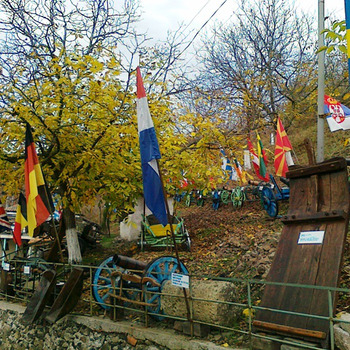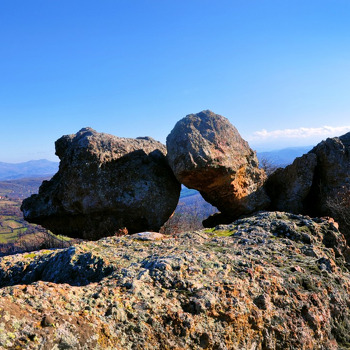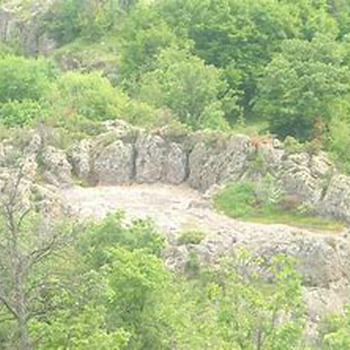Rock niches
Overview
The Thracian cult complex near the village of Drumche and the cult site "Yumurlu kaya" (also known as "Yumruk kaya" - "fist-shaped rock" and "the lion") near the village of Obichnik are part of an ancient sacred rock space. The rock cult sites are located about 1 km southwest of the village of Drumche and 1.5 km from the village of Obichnik (Momchilgrad municipality).
The rock cult complex consists of two rock massifs, spaced at distances of about 200 m from each other, with many trapezoidal niches cut into them. Their total number is about 60, and apparently some of the niches are left unfinished. The rock massifs can be seen from the continuation of the cult complex - near the village of Obichnik, located on a rock resembling an animal figure and called by the locals "Yumurlu Kaya" and also "The Lion".
According to Prof. Alexander Fol, the majestic massifs in Phrygia and Thrace, those along the Artescos River (Arda) covered with numerous niches, sometimes more than a hundred in number, are not necropolises, but ritually treated spaces on the face of the Mother Mountain.
Dr. Stefanka Ivanova and the geophysicist Maria Zlatkova hypothesize that the hundreds of trapezoidal niches on the territory of the Eastern Rhodopes, grouped in systems, carry information, probably related to the ancient gold mining.
According to Dr. Ivanova and Prof. Raduncheva, the hundreds of trapezoidal niches are a kind of code left by the ancient miners. The trapezoid was an important geometric figure for the ancient inhabitants of the Rhodopes - the dwellings and temples during the Eneolithic were trapezoidal.
Prof. Rangel Gyurov also defends a similar scientific hypothesis, according to which the Rhodopes were the center of the largest association for gold mining and processing in antiquity. According to him, many of the archeological sites of Thracian antiquity in the mountains are not altars or places of worship, but facilities for gold mining. The carved trapezoidal niches in the rocks along the valley of the Arda River and its tributaries served as a kind of marker for gold-bearing rocks. This mining information system indicated which layer was gold-bearing.
According to Assoc. Prof. Georgi Nehrizov, in the Central part of the Eastern Rhodopes, including the Arda catchment area along its middle course, is the area of distribution of the monuments carved into the rocks, which were the main burial facilities of the Thracians during the Early Iron Age. Its borders are not geographically separated, but are outlined by the registered rock megalithic monuments - rock tombs and graves, and groups of rock niches.
The hypothesis that urns with the ashes of the deceased were placed in the rock niches, as their size did not allow the body of the deceased to fit inside, according to Prof. Valeria Fol will require confirmation, because it is very difficult and even physically unlikely on these inaccessible rocks, on which one can descend only from the top with a rope, funeral rites have been performed and the cult of the dead has been maintained. As with the holes in the horizontal rocks, so with the high-rock niches, carving can be assumed as a one-time ritual act and sacred objects (intermediaries or votive offerings) may be placed in the niches on certain days associated with a cosmogonic or initiation rite.
Recommended
- Letovnishki waterfall
- Varbitsa River
- The Big and the Small Cauldron- Golemiat i Malak Kazan
- Thracian fortress in the village of Lisitsite
- Chit kaya
- Church of the Assumption - Kardzhali
- Open-air museum of the Rhodope traditions- Batkovtsi village


 Bulgarian
Bulgarian Romanian
Romanian




